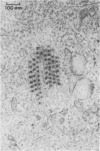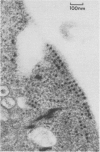Abstract
The isolation and preliminary characterization of a virus from domestic mink- are reported. The virus was tentatively classified as a member of the family Picornaviridae on the basis of its physicochemical properties. The mink virus was not neutralized by antiserum to some known members of the calicivirus genus, which included the nine serotypes of vesicular exanthema of swine virus, ten serotypes of San Miguel sea lion virus and feline calicivirus. Seroepidemiological studies indicated that the incidence of mink virus infection was widespread in domestic mink populations. Although the virus was isolated from mink on ranches with a history of hemorrhagic pneumonia (pseudomonas pneumonia), no specific disease process could be attributed to the virus infection.
Full text
PDF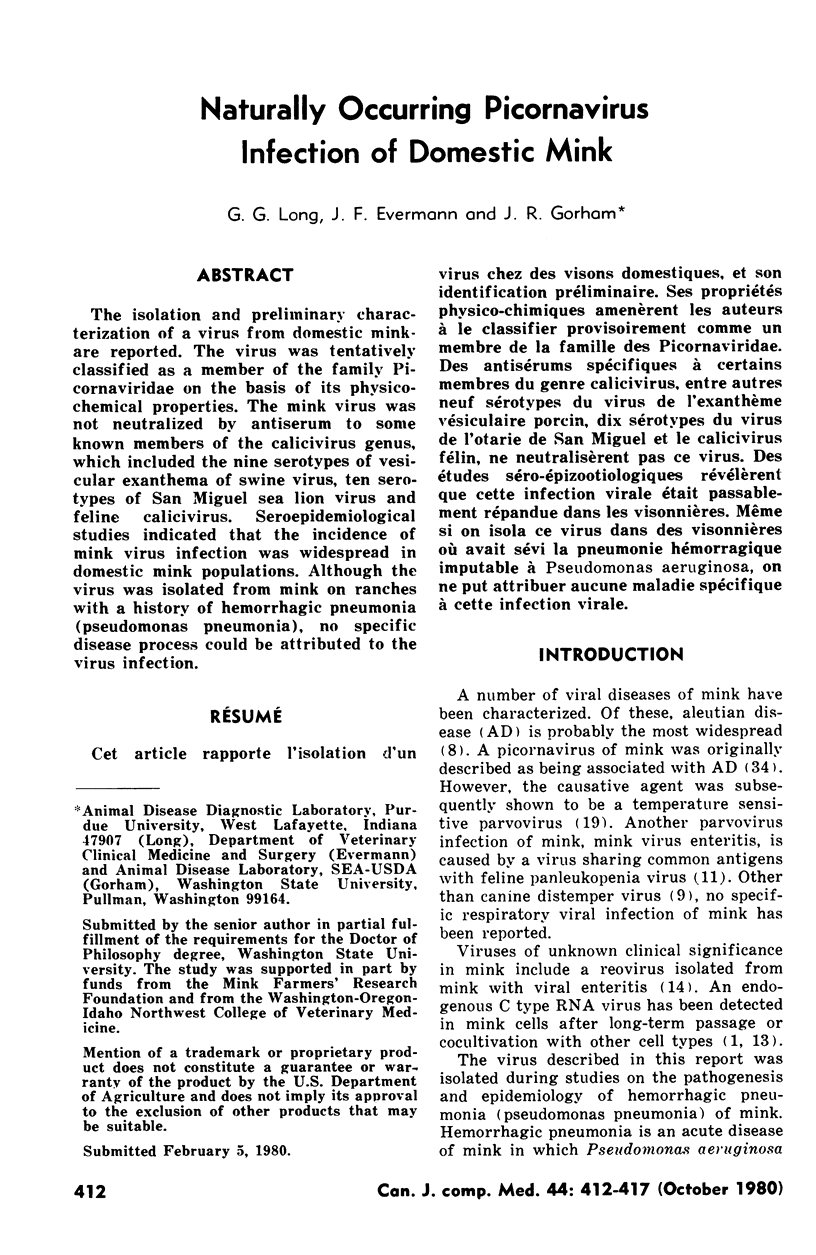
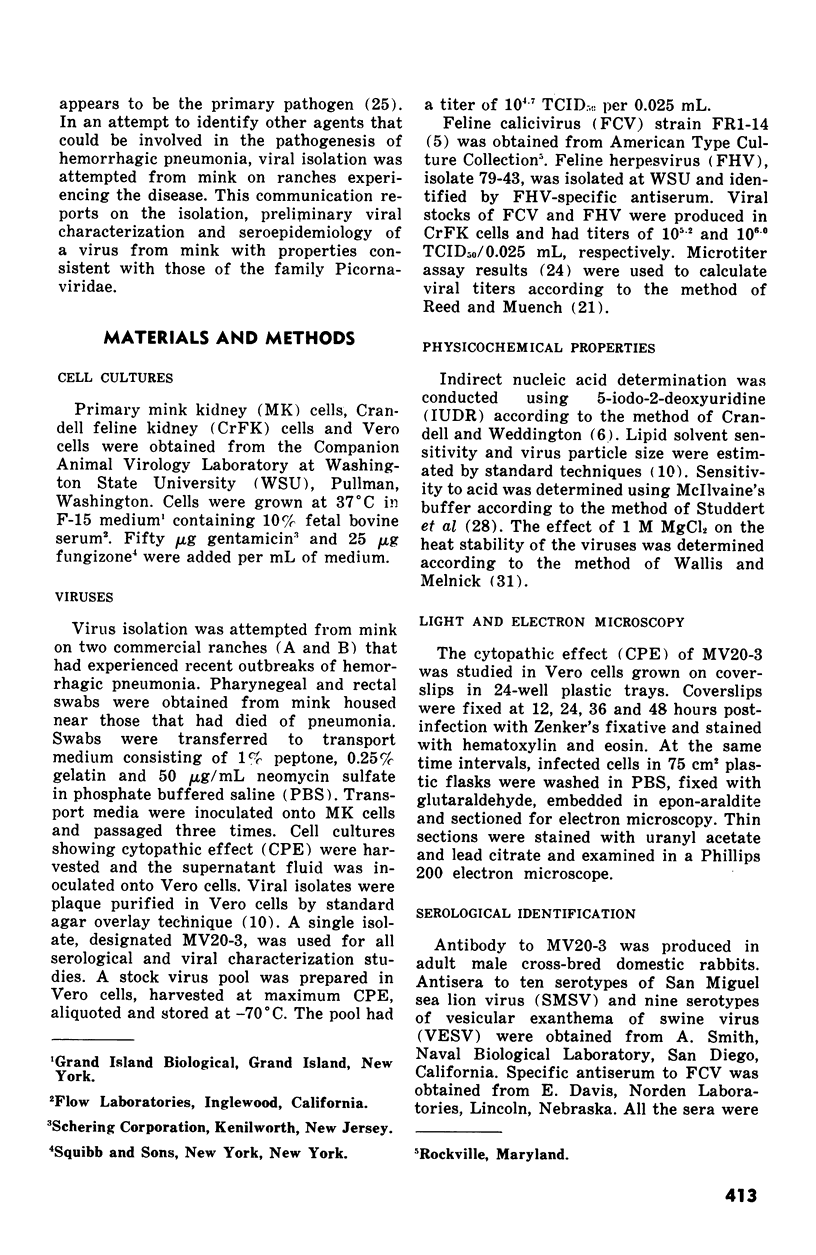
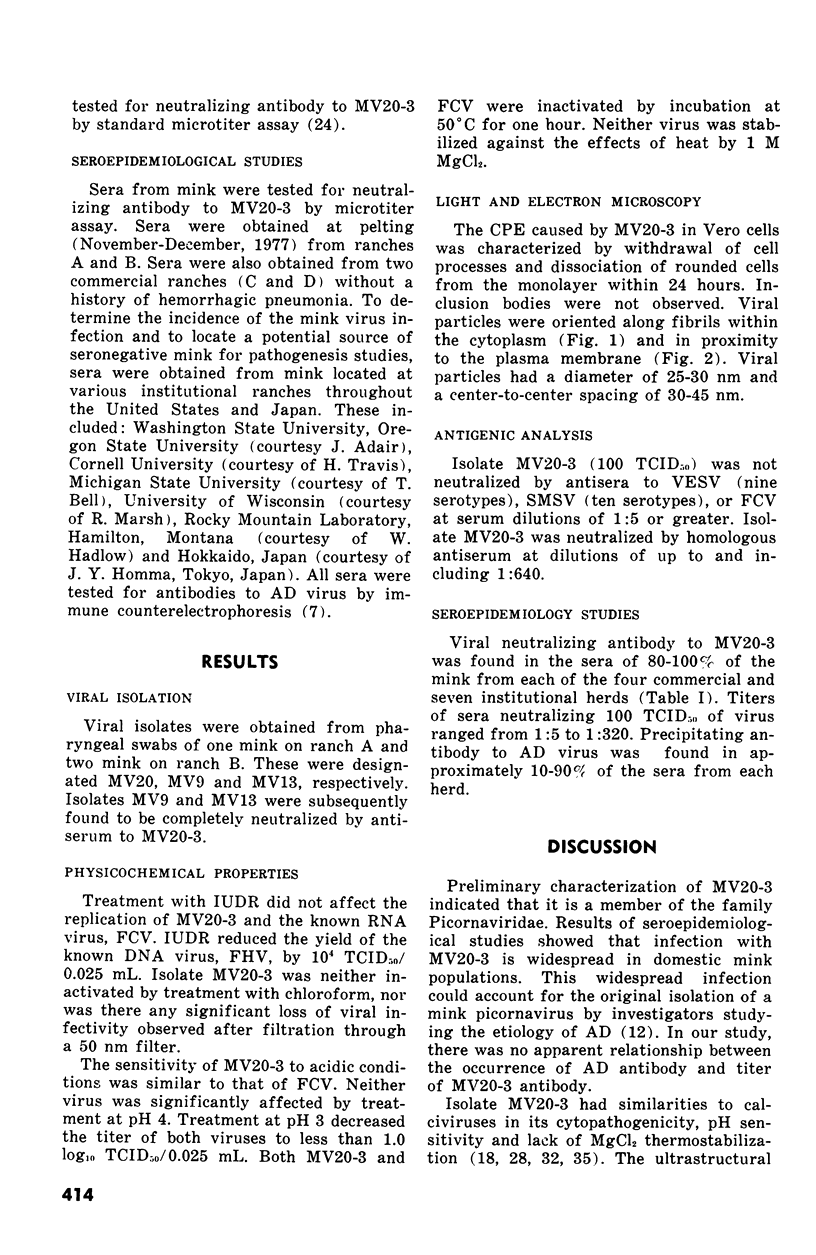
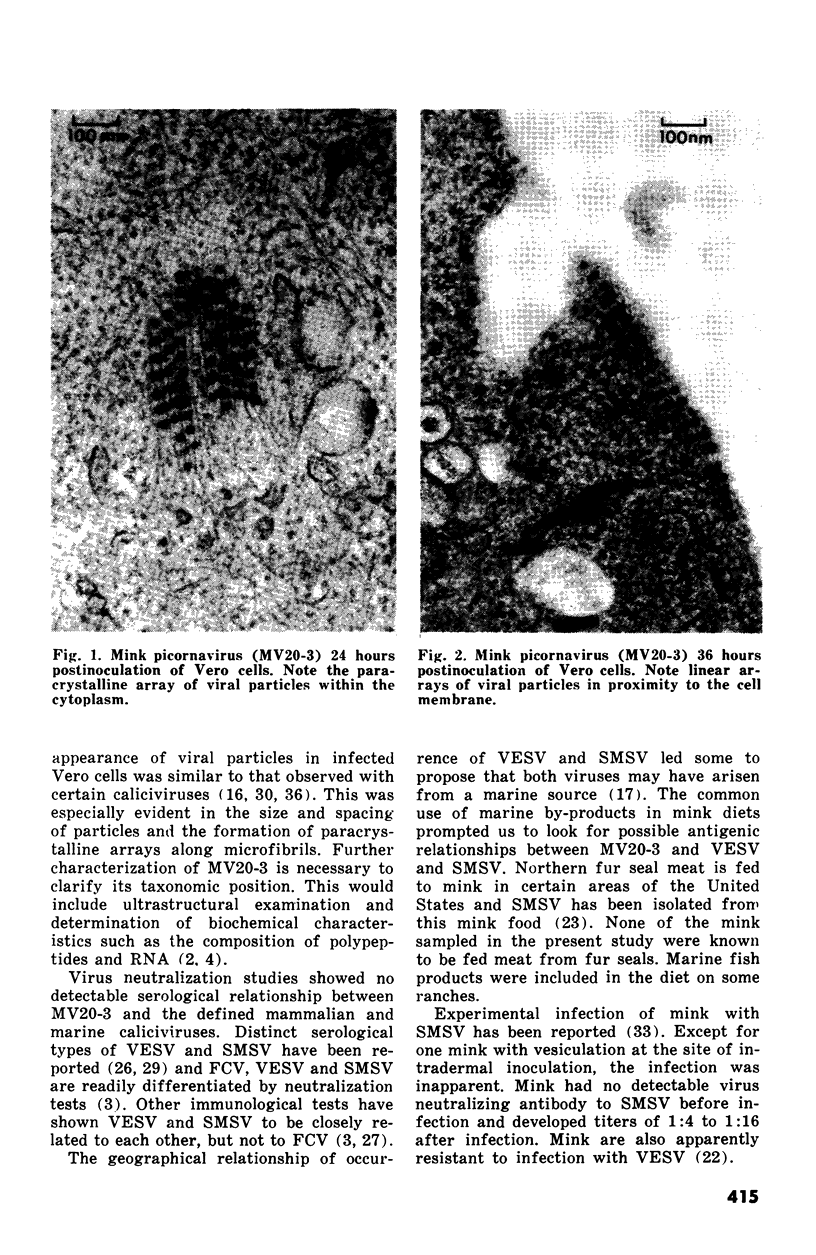
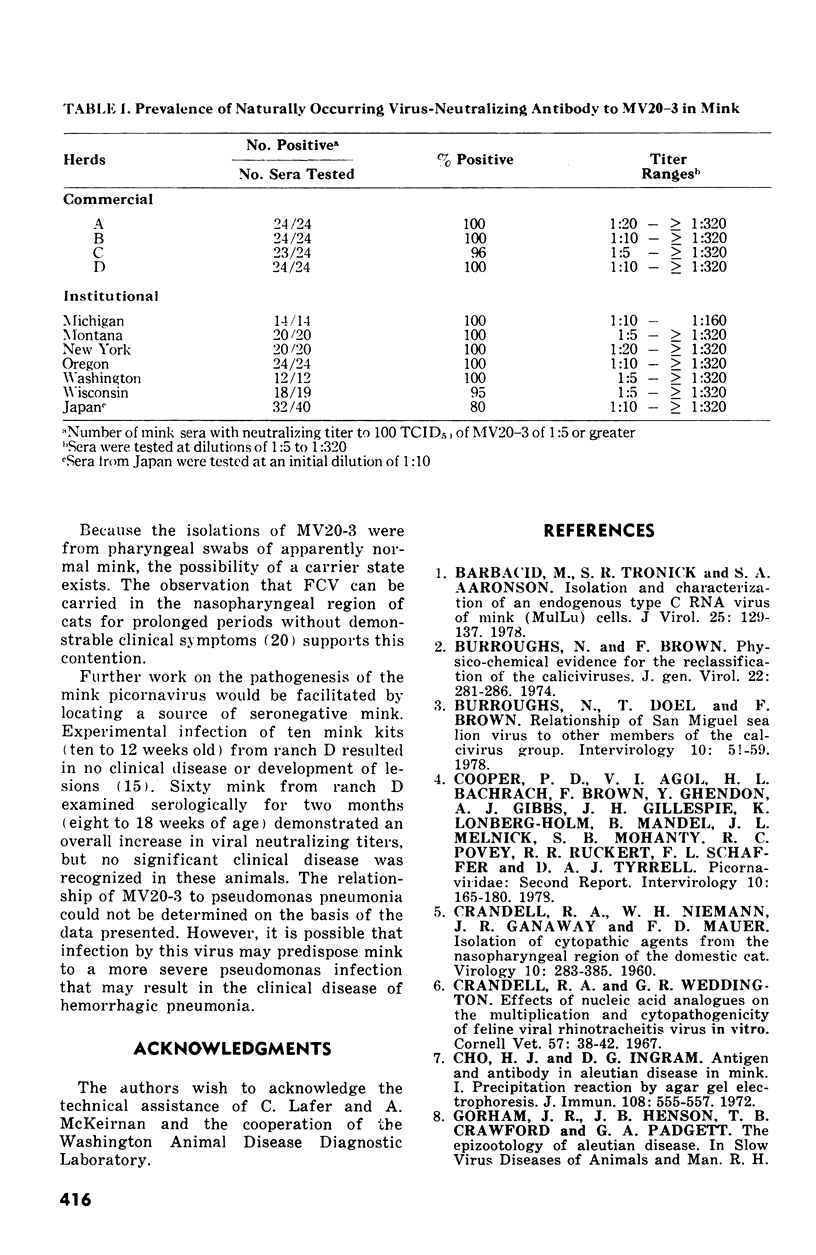
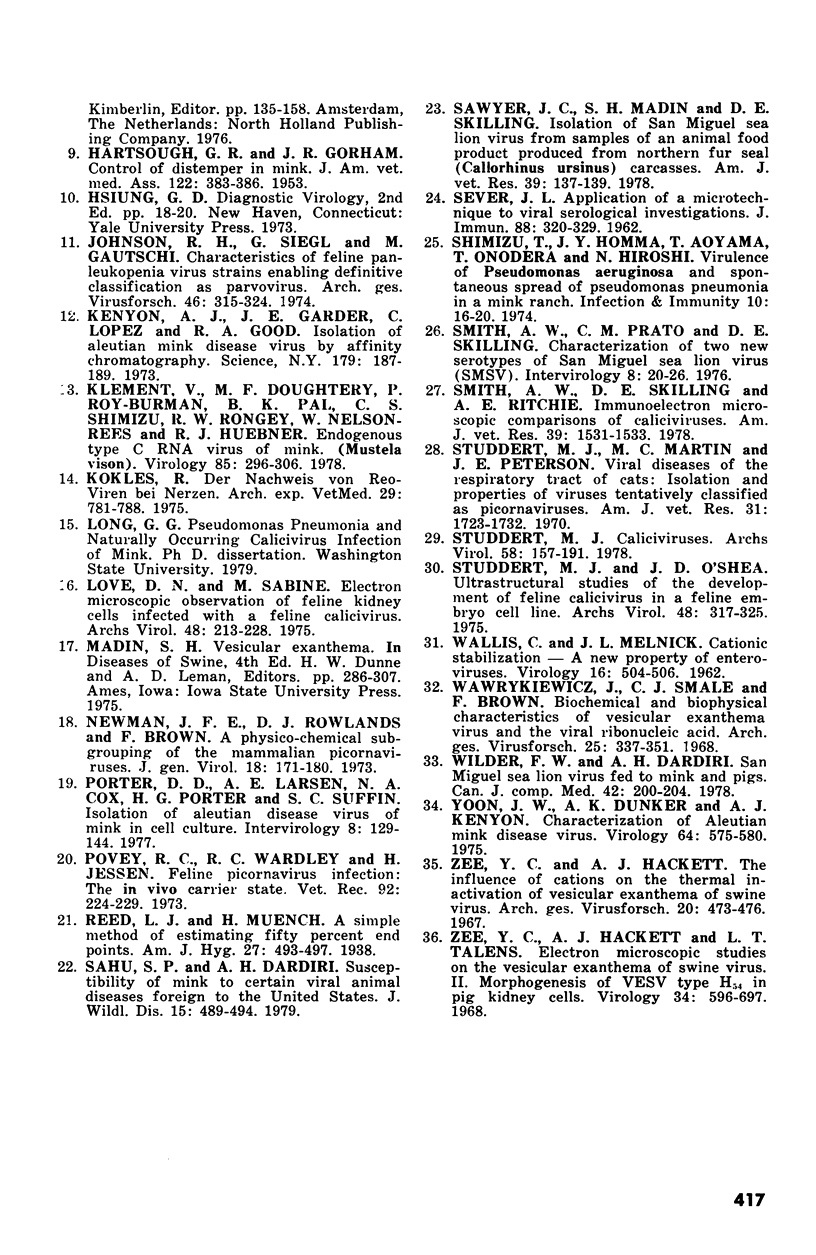
Images in this article
Selected References
These references are in PubMed. This may not be the complete list of references from this article.
- Barbacid M., Tronick S. R., Aaronson S. A. Isolation and characterization of an endogenous type C RNA virus of mink (Mv1Lu) cells. J Virol. 1978 Jan;25(1):129–137. doi: 10.1128/jvi.25.1.129-137.1978. [DOI] [PMC free article] [PubMed] [Google Scholar]
- Burroughs J. N., Brown F. Physico-chemical evidence for the re-classification of the caliciviruses. J Gen Virol. 1974 Feb;22(2):281–286. doi: 10.1099/0022-1317-22-2-281. [DOI] [PubMed] [Google Scholar]
- Burroughs N., Doel T., Brown F. Relationship of San Miguel sea lion virus to other members of the calicivirus group. Intervirology. 1978;10(1):51–59. doi: 10.1159/000148968. [DOI] [PubMed] [Google Scholar]
- CRANDELL R. A., NIEMANN W. H., GANAWAY J. R., MAURER F. D. Isolation of cytopathic agents from the nasopharyngeal region of the domestic cat. Virology. 1960 Feb;10:283–285. doi: 10.1016/0042-6822(60)90049-0. [DOI] [PubMed] [Google Scholar]
- Cho H. J., Ingram D. G. Antigen and antibody in Aleutian disease in mink. I. Precipitation reaction by agar-gel electrophoresis. J Immunol. 1972 Feb;108(2):555–557. [PubMed] [Google Scholar]
- Crandell R. A., Weddington G. R. Effects of nucleic acid analogues on the multiplication and cytopathogenicity of feline viral rhinotracheitis virus in vitro. Cornell Vet. 1967 Jan;57(1):38–42. [PubMed] [Google Scholar]
- HARTSOUGH G. R., GORHAM J. R. Control of distemper in mink. J Am Vet Med Assoc. 1953 May;122(914):383–386. [PubMed] [Google Scholar]
- Johnson R. H., Siegl G., Gautschi M. Characteristics of feline panleucopaenia virus strains enabling definitive classification as parvoviruses. Arch Gesamte Virusforsch. 1974;46(3-4):315–324. doi: 10.1007/BF01240073. [DOI] [PubMed] [Google Scholar]
- Kenyon A. J., Gander J. E., Lopez C., Good R. A. Isolation of Aleutian mink disease virus by affinity chromatography. Science. 1973 Jan 12;179(4069):187–189. doi: 10.1126/science.179.4069.187. [DOI] [PubMed] [Google Scholar]
- Klement V., Dougherty M. F., Roy-Burman P., Pal B. K., Shimizu C. S., Rongey R. W., Nelson-Rees W., Huebner R. J. Endogenous type C RNA virus of mink (Mustela vison). Virology. 1978 Mar;85(1):296–306. doi: 10.1016/0042-6822(78)90433-6. [DOI] [PubMed] [Google Scholar]
- Kokles R. Der Nachweis von REO-Viren bei Nerzen. Arch Exp Veterinarmed. 1975;29(5):781–788. [PubMed] [Google Scholar]
- Love D. N., Sabine M. Electron microscopic observation of feline kidney cells infected with a feline calicivirus. Arch Virol. 1975;48(3):213–228. doi: 10.1007/BF01317964. [DOI] [PubMed] [Google Scholar]
- Newman J. F., Rowlands D. J., Brown F. A physico-chemical sub-grouping of the mammalian picornaviruses. J Gen Virol. 1973 Feb;18(2):171–180. doi: 10.1099/0022-1317-18-2-171. [DOI] [PubMed] [Google Scholar]
- Picornaviridae: second report. Intervirology. 1978;10(3):165–180. doi: 10.1159/000148981. [DOI] [PubMed] [Google Scholar]
- Porter D. D., Larsen A. E., Cox N. A., Porter H. G., Suffin S. C. Isolation of Aleutian disease virus of mink in cell culture. Intervirology. 1977;8(3):129–144. doi: 10.1159/000148888. [DOI] [PubMed] [Google Scholar]
- Povey R. C., Wardley R. C., Jessen H. Feline picornavirus infection: the in vivo carrier state. Vet Rec. 1973 Mar 3;92(9):224–229. doi: 10.1136/vr.92.9.224. [DOI] [PubMed] [Google Scholar]
- SEVER J. L. Application of a microtechnique to viral serological investigations. J Immunol. 1962 Mar;88:320–329. [PubMed] [Google Scholar]
- Sahu S. P., Dardiri A. H. Susceptibility of mink to certain viral animal diseases foreign to the United States. J Wildl Dis. 1979 Jul;15(3):489–494. doi: 10.7589/0090-3558-15.3.489. [DOI] [PubMed] [Google Scholar]
- Sawyer J. C., Madin S. H., Skilling D. E. Isolation of San Miguel Sea Lion Virus from Samples of an animal food product produced from northern fur seal (Callorhinus ursinus) carcasses. Am J Vet Res. 1978 Jan;39(1):137–139. [PubMed] [Google Scholar]
- Shimizu T., Homma J. Y., Aoyama T., Onodera T., Noda H. Virulence of Pseudomonas aeruginosa and spontaneous spread of pseudomonas pneumonia in a mink ranch. Infect Immun. 1974 Jul;10(1):16–20. doi: 10.1128/iai.10.1.16-20.1974. [DOI] [PMC free article] [PubMed] [Google Scholar]
- Smith A. W., Skilling D. E., Ritchie A. E. Immunoelectron microscopic comparisons of caliciviruses. Am J Vet Res. 1978 Sep;39(9):1531–1533. [PubMed] [Google Scholar]
- Studdert M. J. Caliciviruses. Brief review. Arch Virol. 1978;58(3):157–191. doi: 10.1007/BF01317600. [DOI] [PubMed] [Google Scholar]
- Studdert M. J., Martin M. C., Peterson J. E. Viral diseases of the respiratory tract of cats: isolation and properties of viruses tentatively classified as picornaviruses. Am J Vet Res. 1970 Oct;31(10):1723–1732. [PubMed] [Google Scholar]
- Studdert M. J., O'Shea J. D. Ultrastructural studies of the development of feline calicivirus in a feline embryo cell line. Arch Virol. 1975;48(4):317–325. doi: 10.1007/BF01317430. [DOI] [PubMed] [Google Scholar]
- WALLIS C., MENICK J. L. Cationic stabilization--a new property of enteroviruses. Virology. 1962 Apr;16:504–506. doi: 10.1016/0042-6822(62)90234-9. [DOI] [PubMed] [Google Scholar]
- Wawrzkiewicz J., Smale C. J., Brown F. Biochemical and biophysical characteristics of vesicular exanthema virus and the viral ribonucleic acid. Arch Gesamte Virusforsch. 1968;25(3):337–351. doi: 10.1007/BF01556562. [DOI] [PubMed] [Google Scholar]
- Wilder F. W., Dardiri A. H. San Miguel sea lion virus fed to mink and pigs. Can J Comp Med. 1978 Apr;42(2):200–204. [PMC free article] [PubMed] [Google Scholar]
- Yoon J. W., Dunker A. K., Kenyon A. J. Characterization of Aleutian mink disease virus. Virology. 1975 Apr;64(2):575–580. doi: 10.1016/0042-6822(75)90137-3. [DOI] [PubMed] [Google Scholar]
- Zee Y. C., Hackett A. J., Talens L. T. Electron microscopic studies on the vesicular exanthema of swine virus. II. Morphogenesis of VESV type H54 in pig kidney cells. Virology. 1968 Apr;34(4):596–607. doi: 10.1016/0042-6822(68)90081-0. [DOI] [PubMed] [Google Scholar]
- Zee Y. C., Hackett A. J. The influence of cations on the thermal inactivation of vesicular exanthema of swine virus. Arch Gesamte Virusforsch. 1967;20(4):473–476. doi: 10.1007/BF01275230. [DOI] [PubMed] [Google Scholar]



